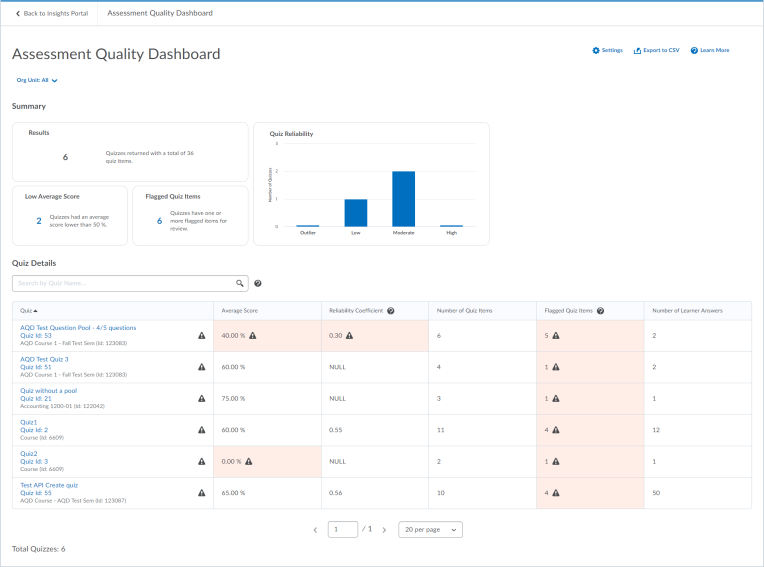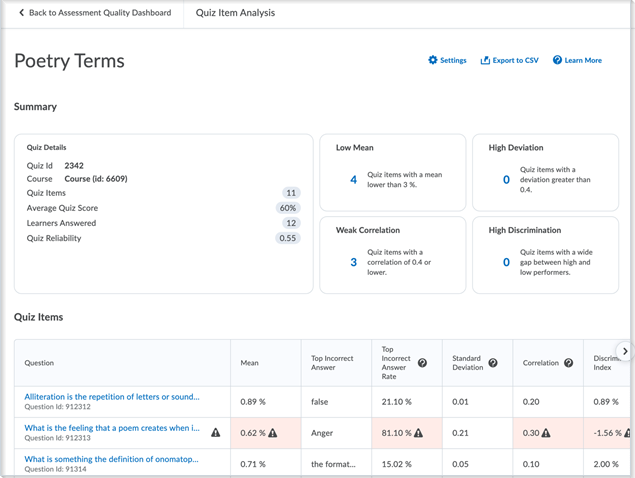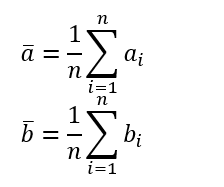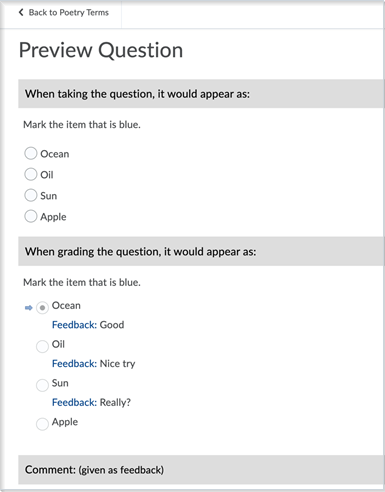This dashboard provides visualizations to help users understand the quality of assessments using quiz and question statistics such as reliability, average grade, and correlation for all quiz and question types.
The Assessment Quality Dashboard is available to all clients who have the Performance+ package or who have purchased Brightspace Insights in the previous packaging model.
To see the Assessment Quality Dashboard, your role must have the Can See Assessment Quality Dashboard permission, and you must be enrolled in the course offerings whose assessments you want to see. Quizzes need at least one attempt to be included in the dashboard.
Viewing and interacting with the Assessment Quality Dashboard
The dashboard has 3 views: the landing page, the Quiz Item Analysis area, and the Preview Question area. The dashboard contains the following functionality:
In general, when using quiz and question statistics, it is important to keep in mind the sample size for the given quiz or question. Metrics increase in statistical relevance as the sample size increases.
The landing page
The landing page shows you visualizations combining the data from all the quizzes that you manage. The data on this page enables you to analyze and identify quizzes that are underperforming in terms of grade scores and reliability.

Figure: Assessment Quality Dashboard landing page.
Under Summary, there are cards for Results (the number of quizzes that you manage and meet the criteria applied to the dashboard), Average Score, Flagged Question (the number of quizzes with one or more questions that are outside the set threshold for acceptable values), and Quiz Reliability. You can turn these cards on and off and adjust the thresholds in Settings.
The Quiz Details area contains a dynamic table of quizzes that meet the criteria applied to the dashboard. An "!" icon appears next to quizzes that have one or more flagged questions. Click on any of the quizzes in this table to navigate to the Quiz Item Analysis page for that quiz.
If you want to compare multiple occurrences of the same quiz to see how the statistics vary, enter the name of the quiz in the search input above the quiz table. This applies a filter to the entire dashboard. Quizzes only display if their name matches your search, and org units only display if they contain a quiz whose name matches your search. The search input has truncation limits of 5,000 org units and 50,000 quizzes, so if you have access to a very large number of org units, we advise filtering by org unit prior to filtering by quiz name for best results.
The Quiz Details table includes the following:
| Column Name |
Column Description |
|---|
| Quiz |
Name of the quiz, truncated to 160 characters, and unique identifier. Also includes the name and ID of the course offering it is a part of. |
| Average Score |
Calculated as a percentage using the score for each user's first attempt at the quiz. |
| Reliability Coefficient |
Reliability is calculated for all questions whether the quiz questions are all dichotomous or not. Reliability will usually range from 0 to 1, but negative values are possible.
Note: For more information about how the reliability coefficient is calculated, see Calculating Reliability, below.
|
| Number of Quiz Items |
Total number of questions in the quiz. |
| Flagged Quiz Items |
Number of questions that are outside the set threshold for acceptable values in the quiz. |
| Number of Learner Answers |
Number of distinct users who have attempted the quiz. |
In the Assessment Quality Dashboard, for every course, there is a reliability coefficient for each quiz that has one attempt. Reliability is calculated for all questions, whether the quiz questions have two possible answers (such as true or false) or not. Reliability ranges from 0-1; however, negative values are possible.
Reliability is calculated as follows:

Where:
k = total number of questions in the quiz.
(σ_(question i) )2 = the variance for a particular question score i
(σ_(quiz,all) )2 = the variance of the quiz scores (based on all learners)
The Quiz Item Analysis area
Click on a quiz to navigate to the Quiz Item Analysis area, which provides a breakdown of each question in a quiz.

Figure: The Quiz Item Analysis area.
Click on Go to quiz under the name of the quiz, and the Edit Quiz page opens in a new window.
Under Summary, there are cards for Quiz Details which includes the details from the previous page, Low Mean which counts the number of quiz items with a mean lower than your threshold, High Deviation which counts the number of quiz items with a deviation greater than your threshold, Weak Correlation which counts the number of quiz items with a correlation lower than your threshold, and High Discrimination which counts the quiz items with a wide gap between low and high performers. You can turn these cards on and off and alter the thresholds in Settings.
The Quiz Items area contains a dynamic table of quiz items that meet the criteria applied to the dashboard. An "!" icon appears next to quizzes that have one or more statistics out of range of the set threshold. Click on any of the quiz items in this table to navigate to the Preview Question page for that quiz item.
The Quiz Items table displays statistics and details about each question in the quiz, including:
| Column Name |
Column Description |
|---|
| Question |
Question text, truncated to 70 characters, and a unique identifier. |
| Mean |
Calculated as a percentage to two decimal places using the score for each user's first attempt at the question. |
| Top Incorrect Answer |
Most frequently reported incorrect answer. Only populated for multiple choice and true or false questions. |
| Top Incorrect Answer Rate |
Response rate between 0 and 1 for those who selected the most common incorrect answer. Only populated for multiple choice and true or false questions. |
| In Question Pool |
Indicates if the question is part of a question pool (yes or no). |
| Standard Deviation |
The standard deviation of the grade of the question using each user's first attempt. |
| Correlation |
This calculates any possible correlation between the question score and the total quiz score. Displays N/A when all users answer the question correctly.
Note: For more information, see Calculating Correlation, below.
|
| Discrimination Index |
This calculates any possible discrimination in the question between the higher and lower performing learners by subtracting the question's lower 27% from its upper 27%. The higher the difference, the better the question discriminates between high and low performing learners. A negative value indicates that more low performing learners are correctly answering the question than high performing learners. This would most likely indicate a flawed quiz question. |
| Upper 27% |
Average question grade of the users with quiz grades in the top 27%.
Note: when there are 10 or fewer question attempts, the upper and lower 50% is considered instead of 27%. This makes the statistic relevant with smaller sample sizes.
|
| Lower 27% |
Average question grade of the users with quiz grades in the lowest 27%. |
Correlation values in the Assessment dashboard show the correlation between the question score and the total quiz score. It measures the strength of the correlation between the two values and shows either a positive or a negative relationship ranging from -1.00 to +1.00.
If the question has only two possible answers (dichotomous questions), such as true or false, the dashboard uses point biserial correlation. If the questions are not dichotomous, such as short answer questions, the dashboard calculations are based on Pearson correlation.
Point biserial correlation is calculated as follows:

Where:
y1=Number of correct answers
y0=Number of incorrect answers
M1= Average quiz score for those with the correct answer
M0= Average quiz score for those with the incorrect answer
n=Number of unique user attempts for the question
Pearson Correlation is calculated as follows:

Where :
n=Number of unique user attempts for the question
a=Question score
b=Quiz score
ai=Individual question scores indexed with i
bi= Individual quiz scores indexed with i

The Preview Question area
Click on a quiz question to navigate to the Preview Question area, where you can preview quiz questions, comments, and hints.

Figure: The Preview Question area.
About Rounding
For all of the metrics on the Assessment Quality Dashboard, rounding is performed only once, at the end of the calculation. Different metrics have different numbers of final decimal places. If the digit in the final decimal place is followed by digit greater than or equal to 5, it is rounded up; if followed by a digit smaller than 5, it remains as-is.
For example, 1.2356 rounded to 2 decimal places becomes 1.24, while 1.2345 becomes 1.23.